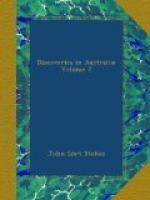MOVE DOWN THE RIVER.
After noon observations, the gig moved down the river. On passing the large island, I shot an animal resembling a water-rat, of large dimensions, particularly expanded across the loins, with stout hind legs and palmated feet, of a light slate colour and soft fine hair approaching fur, the colour gradually becoming lighter under the abdomen; the head was flatter than that of the usual tribe of water-rats, and resembled an otter.*
(Footnote. There is a species of water-rat inhabiting the coast of Australia, called Hydromys chrysogaster; but this was the first time we met with anything like it.)
RETURN TO THE SHIP.
It was not until long after dark that we reached the mouth, where, meeting the yawl, both boats ran out of the river on their return to the ship, distant thirty-three miles. The prevalence of light winds made it noon before we got on board, when I found that in consequence of the tides approaching the springs and falling 12 instead of 6 feet, it had been necessary to move the ship farther off.
During our absence light winds had prevailed; on several days land and seabreezes. The cessation of strong southerly winds kept the temperature about 60 degrees. Mr. Fitzmaurice had returned and gave the following account of his examination.
MR. FITZMAURICE’S EXPLORATION.
Commencing at Mr. Forsyth’s furthest, he found the southerly trend of the coast change in the course of nine miles to the eastward, forming a large shoal bay, which at low-water had a mud flat extending off nearly two miles. The east point of this bay, named Point Tarrant,* I had seen from the south-east end of Sweers Island, bearing South 17 degrees West eighteen miles. It is rendered remarkable by a slight rise in the land behind it, forming low mounds or hillocks. Two miles to the westward Mr. Fitzmaurice discovered an inlet, which he followed a league in a general south-west direction, when it had in no way lost the promising appearance it possessed from its breadth at the mouth, which was further increased by the manner in which the bank was thrown out off it.
(Footnote. After one of the officers who had shared all the hard work, a practice generally adopted.)
Nine miles further westward were two other small openings. Mr. Fitzmaurice’s exploration terminated seventeen miles South 56 degrees East from Point Tarrrant, where another inlet was found of still greater magnitude and importance. The coast between fell back slightly, forming two shallow bights with the usual low monotonous mangrove shores, and extensive frontage of mud. At the distance of six and ten miles from Point Tarrant were two other inlets, the latter of which was large and received Mr. Pasco’s name. It was examined for a short distance in a South by West direction, and presented the usual low banks lined with mangroves. Near the entrance a native came down to the shore to look at the boat; he was very tall and quite naked, and would not allow our party to approach.




